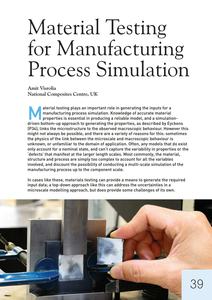
Material testing plays an important role in generating the inputs for amanufacturing process simulation. Knowledge of accurate materialproperties is essential in producing a reliable model, and a simulationdriven bottom-up approach to generating the properties links the microstructure to the observed macroscopic behaviour. However this might not always be possible, and there are a variety of reasons for this: sometimes the physics of the link between the microscale and macroscopic behaviour is unknown, or unfamiliar to the domain of application. Often, any models that do exist only account for a nominal state, and can'’t capture the variability in properties or the 'defects'’ that manifest at the larger length scales. Most commonly, the material, structure and process are simply too complex to account for all the variables involved, and discount the possibility of conducting a multi-scale simulation of the manufacturing process up to the component scale.
In cases like these, materials testing can provide a means to generate the required input data; a top-down approach like this can address the uncertainties in a microscale modelling approach, but does provide some challenges of its own.



